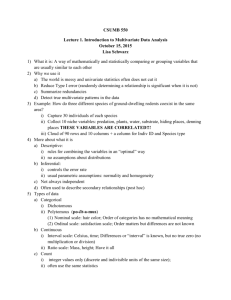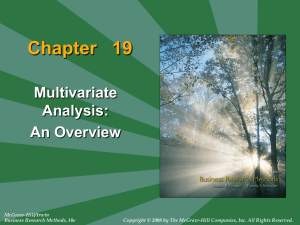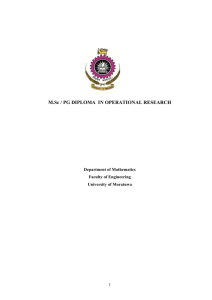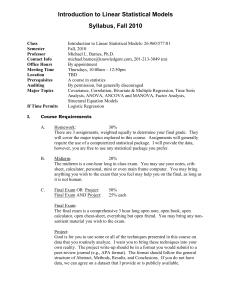Kristina Hash`s overview of multivariate methods
advertisement
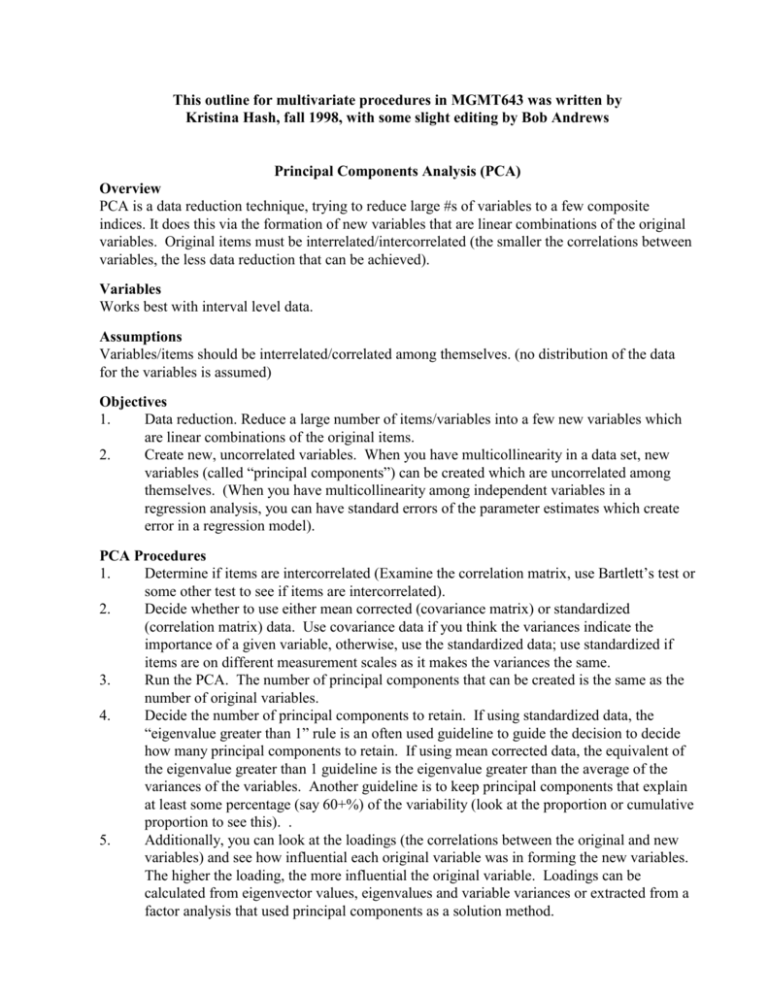
This outline for multivariate procedures in MGMT643 was written by Kristina Hash, fall 1998, with some slight editing by Bob Andrews Principal Components Analysis (PCA) Overview PCA is a data reduction technique, trying to reduce large #s of variables to a few composite indices. It does this via the formation of new variables that are linear combinations of the original variables. Original items must be interrelated/intercorrelated (the smaller the correlations between variables, the less data reduction that can be achieved). Variables Works best with interval level data. Assumptions Variables/items should be interrelated/correlated among themselves. (no distribution of the data for the variables is assumed) Objectives 1. Data reduction. Reduce a large number of items/variables into a few new variables which are linear combinations of the original items. 2. Create new, uncorrelated variables. When you have multicollinearity in a data set, new variables (called “principal components”) can be created which are uncorrelated among themselves. (When you have multicollinearity among independent variables in a regression analysis, you can have standard errors of the parameter estimates which create error in a regression model). PCA Procedures 1. Determine if items are intercorrelated (Examine the correlation matrix, use Bartlett’s test or some other test to see if items are intercorrelated). 2. Decide whether to use either mean corrected (covariance matrix) or standardized (correlation matrix) data. Use covariance data if you think the variances indicate the importance of a given variable, otherwise, use the standardized data; use standardized if items are on different measurement scales as it makes the variances the same. 3. Run the PCA. The number of principal components that can be created is the same as the number of original variables. 4. Decide the number of principal components to retain. If using standardized data, the “eigenvalue greater than 1” rule is an often used guideline to guide the decision to decide how many principal components to retain. If using mean corrected data, the equivalent of the eigenvalue greater than 1 guideline is the eigenvalue greater than the average of the variances of the variables. Another guideline is to keep principal components that explain at least some percentage (say 60+%) of the variability (look at the proportion or cumulative proportion to see this). . 5. Additionally, you can look at the loadings (the correlations between the original and new variables) and see how influential each original variable was in forming the new variables. The higher the loading, the more influential the original variable. Loadings can be calculated from eigenvector values, eigenvalues and variable variances or extracted from a factor analysis that used principal components as a solution method. Factor Analysis (FA) Overview Both PCA and FA procedures are data reduction techniques, trying to reduce large #s of variables to a few composite indices. Both involve the formation of new variables that are linear combinations of the original variables. Factor analysis goes one step further and tries to determine an underlying structure or construct. It seeks to explain how certain variables are correlated. Can be used to develop scales and measure constructs. Variables Works best with interval level data. Assumptions Multivariate normality only if the maximum likelihood solution method is used; Variables/items should be interrelated/correlated among themselves Objectives 1. Identify the smallest # number of factors which best explain or account for the correlations or covariances among the indicators. 2. Identify, via factor rotations, the most plausible factor solution. 3. Estimate the pattern and structure loadings, communalities, and the unique variances of the indicators. 4. Provide an interpretation for the common factors. 5. If necessary, estimate the factor scores. FA Procedures 1. Use KMO and Bartlett’s test (tests to see if DVs are correlated and data is multivariate normal) to see if data appropriate for FA (should be significant). 2. Generation of correlation or covariance matrix. 3. Extraction of initial factor solution (use PCA) and determine number of factors to keep. Can use the same guidelines as for PCA such as “eigenvalue greater than one” rule or look at the cumulative % of variance. 4. Rotation. Rotation helps achieve a simpler and more interpretable factor structure. Can use varimax or quartermax or other rotation (use varimax if you do not suspect the existence of one general factor and use quartermax if you do suspect the presence of one general factor). 5. Interpretation. To interpret the factors, you attach labels or meanings to the factors (name them). To do this, you look at the loadings and identify a pattern among items that load highly (.6 or .5 and above are often used guidelines) on a particular factor. Factors with high loadings will have excellent face validity and appear to be measuring some underlying construct. 6. Can also go on to construction of scales or factor scores to use in further analysis. Multivariate Analysis of Variance (MANOVA) Overview MANOVA is used to assess the statistical significance of the effect of one or more IVs on a set of two or more DVs. It is different from ANOVA because ANOVA uses only 1 DV. Use a MANOVA instead on conducting multiple ANOVAs to control for Type I errors. With MANOVA, you can see if the vectors of means (centroids) for the groups are significantly different. Variables Involves one or more nominal IVs and 2 or more interval DVs. Assumptions Independent observations, multivariate normality (but can violate this especially with an equal number of observations from each cell or group), equal covariances within IV determined groups of DVs. Procedures 1. Determine whether data meet the assumptions. Can run histograms to check for multivariate normality and can use Box's M test to determine whether covariances are equal. 2. Calculate the test statistic which can be the Hotelling’s T2 (the multivariate version of the t-test for 2 groups), Pillai's Trace, Wilks Lambda, Hotelling's Trace, or Roy's Largest Root and look at the significance level. This will show the significance of the effects. 3. If there is a significant difference among any of the groups then one can further investigate the nature of this difference by looking at ANOVA results for individual variables, including Post Hoc Multiple Comparisons for observed means. (In situations with interrelated variables, individual variables may not be significant.) 4. If there is a significant difference among any of the groups then one may be able to build a discriminant function or functions that will allow one to predict group membership for individual data points. If there is no difference in mean vectors (centroids) for the groups then it is virtually impossible to build an effective discriminant model. Discriminant Analysis (DA) Overview Discriminant function analysis is used to determine which variables discriminate between two or more naturally occurring groups and to use those variables to predict group membership of future cases. It tries to determine whether groups differ with regard to the mean of a variable (similar to ANOVA/MANOVA). In general, Discriminant Analysis is a very useful tool (1) for detecting the variables that allow the researcher to discriminate between different (naturally occurring) groups, and (2) for classifying cases into different groups with a better than chance accuracy. The main uses of discriminant analysis are (1) to identify variables that are related to group membership and (2) to predict group membership from a set of predictors. Variables DV is nominal and IVs are interval (1 or 2 qualitative dummy variables may be used). DA Assumptions Observations for Independent Variables have equal variances and covariances for linear discriminant functions but quadratic functions can be developed in the case of unequal covariance matrices. A multivariate normal distribution is assumed for probability estimation. Equal misclassification costs can be used to adjust prior probabilities in a two group problem to account for unequal misclassification costs. Consider two groups A & B with prior probabilities of PA & PB. If C(B|A)/C(A|B)=k then let RA and RB represent the revised prior probabilities where RA = PA*k/(PA*k + PB) and RB = RB/(PA*k + PB).) DA Objectives 1. To identify variables that discriminate best between two or more identifiable groups. 2. Use the identified variables or factors to develop an equation or function for computing a new variable or index that will represent differences between the two or more groups. Conceptually this is equivalent to identifying a new axis and provides maximum separation between two groups. 3. Use the identified variables or index to develop a rule to classify future observations into one of the groups. DA Procedures 1. Determine whether data meets the assumptions. Can run histograms to check for multivariate normality and can use Bartlett’s test to determine whether covariances are equal. (Estimated posterior probabilities of membership in a group and hypothesis tests are based on multivariate normality assumptions. Effective discriminant functions may be developed when the data are not multivariate normal.) 2. Conduct a MANOVA to see if the vectors of means for the groups are significantly different. If they are different, this shows that the centroids of the data for the groups differ significantly. This does not say which variables have different means. 3. Compute discriminant functions to see which variables should be combined in what way to discriminate among the groups. (A stepwise discriminant procedure does this automatically.) Assess the statistical significance to see which variables are most important. Can use p value of F statistic or of Wilks Lambda to assess significance of a variable. A low Wilks Lambda, a high F ratio, and a significant p value indicate an important variable.. 4. Build a model for classifying future cases. Uses stepwise procedures (forward and/or backward) to decide which variables will be included in the model. These procedures use the p value or the F statistic to determine whether to include or exclude a variable (see if it adds significantly to explaining group separation or not). DA Procedures (continued) 5. You can then look at the classification results to see what percentage were correctly classified in using the model. Using the same data to create the discriminant model and to determine classification results creates what is referred to as the resubstitution error rates. These tend to underestimate the true error rates for a model. More accurate estimates can be obtained by predicting group membership for data values that were not used to build the model, such as classifying a Holdout sample. Another way is via building models by withholding one data point and then predicting the group for the withheld point and then repeating this for all data points in the set. The summary error rates are more accurate (almost unbiased) than the resubstitution rates. This method is referred to as crossvalidation (SAS & SPSS) or U-Method (Sharma 1996, page 273). The Hold Method uses one part of the data to build a model and another part to assess the classification ability of the model. This method requires a large sample size. Logistic Regression (LR) Overview Logistic Regression is an alternative procedure to DA when the dependent variable has only two groups (as it also can predict group membership) and is an extension of multiple regression. One can use logistic regression when you violate the normality assumption of DA (either because IVs are a mix of categorical and continuous variables or because continuous variables are not normally distributed). Logistic regression is used to predict a dichotomous DV using 1 or more IVs. The DV usually represents the occurrence or non-occurrence of some outcome event. The procedure will produce a formula which will predict the probability of the occurrence as a function of the IVs. It also produces an odds ratio associated with each predictor value. You would use this instead of linear regression when DV is dichotomous and not continuous. It also differs from linear regression as it attempts to predict the probability that an observation belongs to each of two groups as opposed to trying to predict a score on a continuous dependent measure. Multicollinearity poses similar problems for LR as it does for Ordinary Least Squares Regression. Variables A nominal/dichotomous DV with categorical IVs expressed as dummy variables and interval IVs. LR Assumptions Independent observations, mutually exclusive and exhaustive categories, specificity (the model must contain all relevant predictors and no irrelevant predictors). LR Procedures 1. Run stepwise logistic regression procedure which will determine statistically significant predictor variables (uses 2 ). Variables are added or removed based on their likelihood ratios. 2. Evaluate the fit of the model using 2 goodness of fit. This compares the observed values for the subjects in the sample with the predicted values that the subjects should have, based on the model. 4. One can also look at the classification table to see how many observations were correctly predicted, based upon the model. It shows the percent correct. Cluster Analysis (CA) Overview Cluster analysis is a multivariate procedure for detecting natural groupings in data. Cluster analysis classification is based upon the placing of objects into more or less homogeneous groups, in a manner such that the relationship between groups is revealed. The two key steps within cluster analysis are the measurement of distances between objects and the grouping of objects based upon the resultant distances (linkages). It is different from DA because in DA you already know what the different groups are, but in CA you are trying to create groups of similar items and do not know the groups in the beginning. Variables Data are to be interval scale measurements. Assumptions Since no hypothesis tests are performed or probabilities are estimated, cluster analysis has no distributional assumptions for the data. Objectives 1. Group observations into clusters such that each cluster is as homogeneous (similar, uniform) as possible with respect to the clustering variables and the groups are as different as possible. Procedure 1. Select variables to be used as criteria for cluster formation (select a measure of similarity). 2. Select procedure for measuring distance or similarity between each data point (Euclidean distance is often used for points) and then between clusters (linkage method). Linkage methods for hierarchiacal clustering include: Single Linkage or Nearest Neighbor, Complete Linkage or Furthest Neighbor, Median or Average Linkage, Centroid Method, and Ward’s Method with each having a different method for measuring distances between clusters. 3. Form clusters (either by using hierarchical clustering or nonhierarchical clustering; nonhierarchical involves knowing the number of clusters beforehand). 4. Interpret results. This is similar to interpretation in FA as you are naming clusters based upon similar characteristics, but you are also determining how many clusters exist. One can look at a dendrogram which shows how items are put together in groups. In this chart one can look at the distance between the joining of clusters to help decide how many clusters should be used.
